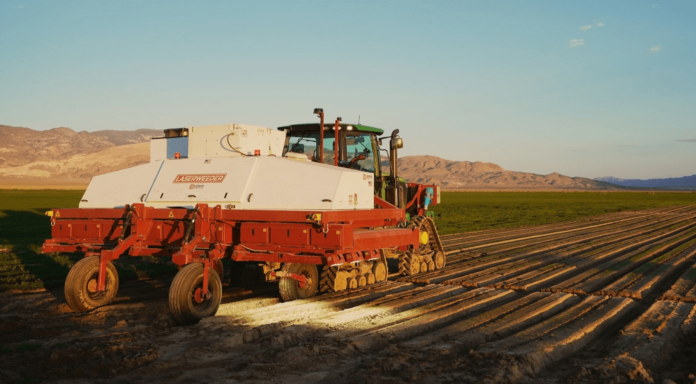Despite all the attention on flashy new artificial intelligence tools like ChatGPT, the challenges of regulating AI, and doomsday scenarios of super-intelligent machines, AI is a useful tool in many areas. In fact, it has enormous potential to benefit humanity.
In agriculture, farmers are increasingly using AI-powered tools to tackle challenges that threaten human health, the environment and food security. Researchers predict that the market for these tools will reach $12 billion by 2032.
As a researcher in the field of agricultural and rural policy, I have [Joe Hollis PhD student, at Iowa State University and author of the article] see three promising developments in AI in agriculture: federated learning, pest and disease detection, and price forecasting.
Pool data without sharing it
Robotics, sensors and information technology are increasingly used in agriculture. These tools are intended to help farmers improve efficiency and reduce chemical use. Furthermore, the data collected by these tools can be used in software that uses machine learning to improve management systems and decision-making. However, these applications typically require data sharing between stakeholders.
A survey of U.S. farmers found that more than half of respondents said they do not trust their data to federal agencies or private companies. This lack of trust is related to concerns that sensitive information will be compromised or used to manipulate markets and regulations. Machine learning could alleviate these concerns.
Federated learning is a technique in which a machine learning algorithm is trained on data from multiple parties, without the parties having to reveal their data to each other. In federated learning, a farmer posts data to a local computer that the algorithm can access, rather than sharing the data on a central server. This method increases privacy and reduces the risk of compromise.
If farmers can be convinced to share their data in this way, they can contribute to a collaborative system that helps them make better decisions and achieve their sustainability goals. For example, farmers could pool data about the conditions for their chickpea crops, and a model trained on all their data could give each of them better predictions about their chickpea yields than models trained only on their own data.
Detecting pests and diseases
Farmers’ livelihoods and global food security are increasingly threatened by plant diseases and pests. The Food and Agriculture Organization estimates that global annual losses from pests and diseases total $290 billion, affecting 40% of global crop production.
Farmers typically spray crops with chemicals to prevent outbreaks. However, the excessive use of these chemicals is linked to harmful effects on human health, soil and water quality and biodiversity. Worryingly, many pathogens are becoming resistant to existing treatments, and developing new treatments is proving difficult.
Reducing the amount of chemicals used is therefore paramount, and AI can be part of a solution.
The Consortium of International Agricultural Research Centers has created a mobile phone app that identifies pests and diseases. The ‘Tumaini’ app allows users to upload a photo of a suspected pest or disease, which the AI compares to a database of 50,000 images. The app also provides analysis and can recommend treatment programs.
When used in conjunction with farm management tools, such apps can improve farmers’ ability to target spraying and improve accuracy when deciding how many chemicals to use. Ultimately, these efficiencies can reduce pesticide use, reduce the risk of resistance, and prevent spillover effects that harm both people and the environment.
Crystal ball for prizes
Market volatility and fluctuating prices affect how farmers invest and decide what to grow. This uncertainty can also discourage farmers from taking risks on new developments.
AI can help reduce this uncertainty by predicting prices. For example, services from companies like Agtools, Agremo and GeoPard offer AI-powered decision tools for agricultural businesses. These tools enable real-time analysis of price points and market data and provide farmers with data on long-term trends that can help optimize production.
This data allows farmers to respond to price changes and plan more strategically. As farmers’ economic resilience improves, it increases the likelihood that they can invest in new opportunities and technologies that benefit both farms and the larger food system.
AI for good
Human innovation has always produced winners and losers. The dangers of AI are clear, including biased algorithms, data privacy violations, and the manipulation of human behavior. However, it is also a technology that has the potential to solve many problems.
These applications of AI in agriculture are cause for optimism among farmers. If the agricultural sector can advance the usefulness of these inventions while developing strong and sensible frameworks to minimize harm, AI can help reduce the impact of modern agriculture on human health and the environment while improving global food security in the 21st century help improve.
Joe Hollis is a graduate research assistant at Iowa State University. PhD student majoring in sustainable agriculture and rural sociology and minoring in political science. They have worked on previous projects including identifying issues, barriers and opportunities for blockchain technology to improve transparency and provenance in Scotland’s dairy supply chain. He is a graduate of both the University of London (BA) and the University of Edinburgh (MSc)
A version of this article was originally posted on The Conversation and is reposted here with permission. Any reposting must cite both the GLP and the original article. Watch The Conversation on Twitter @ConversationUS





